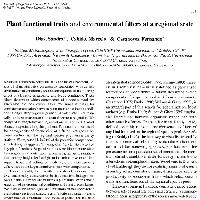Resumen
- . Links between plant traits and the environment, i.e. sets of plant attributes consistently associated with certain environmental conditions, are the consequence of the filtering effect of climatic, disturbance and biotic conditions. These filters determine which components of a species pool are assembled into local communities. We aimed at testing for consistent association between plant traits and climatic conditions along a steep regional gradient, divided into 13 climatically homogeneous sectors, in central-western Argentina. We analyzed 19 vegetative and regeneration traits of the 100 most abundant species along the gradient. For each trait, we tested for homogeneity of frequencies of different categories between sectors and the regional species pool, using the χ2 statistic. We rejected H0 in 71% of the pair-wise comparisons, which strongly suggests a ‘filtering effect’ of climatic factors on key plant functions. Vegetative traits were filtered more often than regeneration traits. Specific leaf area, life span, ramification, canopy height, leaf weight ratio, carbon investment into support tissue and pollination mode were the traits showing differences in the largest number of pair-wise comparisons. This is probably the first attempt to detect, on a quantitative, statistically conservative basis, consistent linkages between climatic factors and numerous plant traits, over a broad spectrum of environmental conditions and plant growth forms. We discuss the advantages and limitations of this approach in predicting vegetation structure and functioning under present environmental conditions, and those expected for the next century as a consequence of global change.
